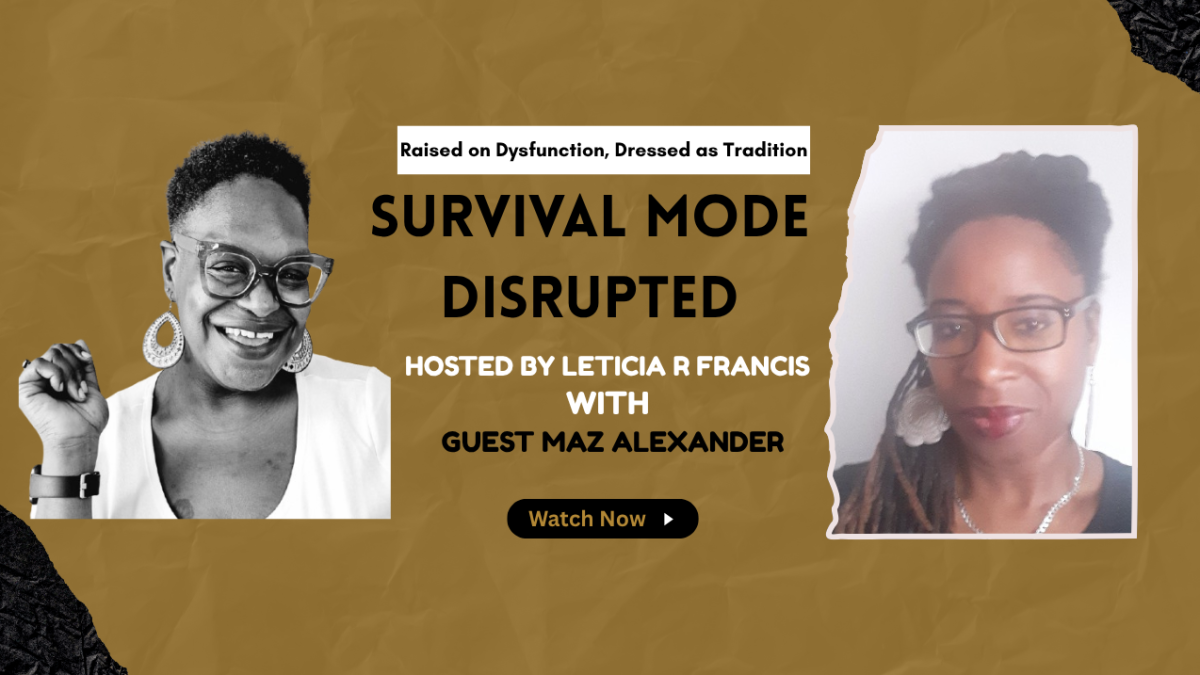Raised on Dysfunction, Dressed as Tradition

When silence is survival and strength is a mask—Maz’s story shows how breaking tradition can save your life.
If you’ve ever carried pain so long it started to feel like a personality, this one’s for you.
For Maz, survival wasn’t a season. It was the water she was baptized in—normalized harm, generational stoicism, spiritual “rules” that sounded holy but landed like handcuffs. She calls it the wilderness: dry, barren, quiet to the world but loud with ache. Where you’re dutiful. Where you keep going. Where you disappear.
Survival mode is seductive like that. It wraps itself in language we respect—tradition, discipline, strength—until we can’t tell the difference between love and loyalty to our own abandonment.
Maz is a mental wellbeing coach, a social worker, a mother, an author—and yes, a professional clown who turns truth into medicine through laughter. But before any of that, she was a little girl sent “on holiday” to Jamaica and left. A daughter calling out abuse no one would name. A woman taught to be agreeable in rooms that didn’t have her best in mind. A believer who accidentally joined a “church” that was actually a cage.
And yet—she is here. Not polished into perfection, but present in her body, her breath, her boundaries. Today, she shares the map she built by walking it. And we’re going to highlight the three phases that always, always carry us out of survival and into self—Self-Awareness, Reprogramming, Reinvention.
Because you were not built to break. And you damn sure weren’t built to just survive.
What Survival Mode Looked Like (So You Can Recognize It in Yourself)
It looked like autopilot with a smile.
It sounded like “I’m fine” with teeth grinding at night.
It felt like worship on Sunday and walking on eggshells the rest of the week.
For Maz, survival wore many names:
-
Cultural duty: “Children should be seen and not heard.” “Give Uncle a hug.” “Don’t talk back.”
-
Religious pressure: “Forgive and forget.” “Suffer and be still.” “God said stay.”
-
Family secrecy: “That’s just how it is.” “Don’t shame the family.” “We all went through it.”
-
Workplace martyrdom: The caring professions that forgot to care for their own.
-
Body alarms: Insomnia. Tight shoulders. Shallow breath. Dentists asking if her job was stressful because she was grinding down her molars.
When dysfunction is dressed as normal, survival masquerades as character. People praise your resilience while your nervous system keeps screaming in Morse code: not safe, not seen, not settled.
Survival wasn’t just around Maz; it lived inside her. And it had done so for so long that leaving felt like treason.
Phase 1 — Self-Awareness: Naming the Pattern Without Excusing It
Self-awareness often begins in the body, long before the mind is ready to confess.
The insomnia. The panic. The catastrophizing. The “what ifs” playing in a loop so loudly you can’t hear your own yes.
Maz started noticing what her body had been trying to say: This isn’t strength. This is strain.
She began to admit what was always true:
-
Being sent away wasn’t “tough love.” It was abandonment.
-
Being disbelieved wasn’t “old-school parenting.” It was gaslighting.
-
“Forgive and forget” wasn’t spiritual maturity. It was spiritual minimizing—theological duct tape slapped over a wound that required surgery.
-
The constant urge to over-give, over-perform, over-agree wasn’t kindness. It was self-abandonment dressed as care.
Awareness is a grief.
A grief for what should have protected you and didn’t.
A grief for the years you called crisis “normal.”
But it’s also the first mercy: when you stop calling it love, you can start asking for the real thing.
If you’re here: Try saying the unsayable out loud. “What happened to me was not okay.” “My body learned to survive. I’m learning to live.”
Phase 2 — Reprogramming: Unlearning the Rules Survival Wrote on Your Bones
Seeing the pattern hurts. Leaving it is holy work.
Reprogramming asked Maz to exchange inherited scripts for truth—slowly, stubbornly, daily:
-
From silence to speech: Not all secrets deserve your protection. Hidden harm multiplies.
-
From people-pleasing to boundaries: No is a complete sentence and a sacred one. Especially with family.
-
From doctrine to discernment: If a “shepherd” controls your choices, that’s not covering—it’s captivity.
-
From “strong Black woman” to whole Black woman: Strength includes softness, asking for help, and letting yourself be held.
-
From hyper-independence to interdependence: It’s safe to receive. It’s safe to be seen.
-
From shame to self-compassion: You don’t need to “earn” rest, tenderness, or love. You’re already worthy.
Reprogramming looked practical, too:
-
Therapy (and the discernment to leave practitioners who minimized her pain).
-
Breath and body work to re-regulate a nervous system trained for war.
-
Choosing work that aligned with her values—and leaving toxic “care” cultures that confused power with purpose.
-
Writing the story down. Comedy that alchemized sorrow into something soft enough to hold.
-
Traveling solo—eight countries in a year—until she heard her own voice again in a new room.
If you’re here: Start with one boundary. One exit. One honest conversation. One nap. Reprogramming is less about performing healed and more about refusing to abandon yourself again.
Phase 3 — Reinvention: The Self You Build When You Stop Surviving
There is a version of you that only arrives once you stop apologizing for needing oxygen.
Reinvention didn’t make Maz flawless. It made her free.
-
She mothered herself with the tenderness she wasn’t given.
-
She filtered faith through love, not fear—trading spiritual obedience for spiritual integrity.
-
She wrote her book and owned her voice.
-
She built a practice to walk other women out of the wilderness and back to themselves.
-
She laughed—on purpose—because joy is not the reward for healing; it’s the fuel.
Reinvention is not about becoming someone new. It’s about becoming who trauma tried to edit out.
And it’s contagious. Every boundary Maz holds redraws the map for the women coming after her. Every “no” she honors turns into a “yes” to legacy. To softness. To rest.
Four Grounding Practices You Can Start Today
Consider these not as fixes, but as friendships with yourself:
-
Name it to tame it.
Write the sentence you’ve never let yourself say. (“I was abandoned.” “That church harmed me.” “I am allowed to leave.”) -
Nervous system first.
Box breathing. A five-minute walk. Hands on heart and belly. Safety isn’t an idea; it’s a body experience. -
One boundary, one week.
Choose one relationship to practice “no” with—even if your “no” is just waiting 24 hours before responding. -
Replace the script.
When the old rule plays (“be grateful,” “don’t make a fuss”), answer with the new truth:
Gratitude without honesty is performance. I choose honesty.
The Takeaway I Want You to Tattoo on Your Heart
Survival mode teaches you how to stay alive.
It does not teach you how to be lived in.
Self-awareness shows you the pattern.
Reprogramming rewrites the story.
Reinvention lets you become the author.
You are not difficult; you were difficult to dismiss.
You are not “too much”; you were carrying too much alone.
You don’t need permission to heal. But if you want one, here it is:
Go.
Leave the rooms that require your silence.
Unlearn the love that demanded your disappearance.
Choose a life that fits the size of your soul.
Because survival was never the destination. It was training for your thriving.
I’m rooting for your rebellious softness. Maz is too.
📌 Episode Spark Notes (for your journal)
-
Where did I learn to call dysfunction “discipline” or “tradition”?
-
What does my body do when I say “I’m fine”?
-
Which boundary would break the oldest cycle in my family?
-
What would my faith sound like if love—not fear—held the microphone?
Categories: : Podcast
START HERE: YOUR SURVIVAL MODE EXIT PATH
Step 1: Awareness & Understanding
Survival mode isn’t just exhaustion—it’s a cage that tricks you into believing struggle is normal. The longer you stay in it, the harder it is to recognize that life was never meant to feel this heavy.
Step 2: Take the First Step
You’ve spent years surviving—now it’s time to unlearn the patterns that have kept you stuck. Download your FREE Survival Mode Exit Blueprint to uncover the hidden cycles running your life and take your first bold step toward transformation.
Step 3: Listen & Learn
Real stories. Raw truths. No sugarcoating. The Survival Mode Disruption Podcast brings you the voices of survivors and experts who have disrupted survival mode and built a life on their terms—because if they can do it, so can you.
Step 4: BUY The Book
Survival Mode Exit Plan is not another fluffy self-help manual. It’s not about manifesting your way into freedom or faking positivity through pain. It’s a punch-in-the-gut, hold-up-a-mirror kind of book.
Step 5: Get Support
You don’t have to do this alone. Inside the Survival Mode Exodus Membership, you’ll get the deep guidance, strategy, and accountability needed to fully step into your power and stop playing small.
Step 6: JOIN THE MOVEMENT
Survival mode is a lie, and it’s time to disrupt it—together. Connect with a growing community of women who refuse to settle for struggle, subscribe to the Survival Mode Disrupted Newsletter, and take your seat at the table of transformation.
 Leticia Francis
Leticia Francis 
